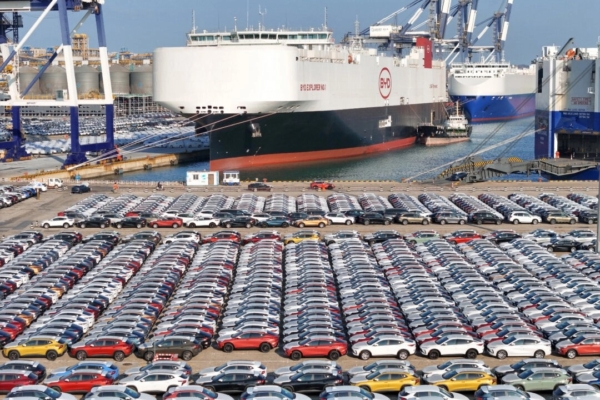In recent years, the export of the “new three items” (electric vehicles, lithium batteries, and solar panels) has been a key industry supported and developed by the Chinese Communist Party (CCP), touted as a new force in exports. However, in the first three quarters of this year, exports have seen a decline of 5.1% year-on-year, with growth rates significantly dropping. Analyses point out that the only sector showing growth, electric vehicles, is facing two major challenges.
According to the spokesperson for the General Administration of Customs, Lu Daliang, in the first three quarters of 2024, China’s exports of electric vehicles, lithium batteries, and photovoltaic products totaled 757.83 billion yuan, accounting for 4.1% of total exports. The export markets of the “new three items” span over 200 countries and regions.
The official website of the Guangzhou Municipal Government of the CCP lavishly praises the “new three items” under the theme “New Three Items in Foreign Trade Shine Brightly, Made in China Continues to Impress Globally.” However, these claims focus more on the advanced technology and foreign favoritism without concrete data to back them up.
Despite the seemingly positive outlook on China’s “new three items” exports, the reality differs. Chinese officials are playing semantic games to showcase a rosier picture than what truly exists.
Public data reveals that in the first three quarters of 2023, the total export value of electric vehicles, lithium batteries, and photovoltaic products reached 798.99 billion yuan, a year-on-year increase of 41.7%, accounting for 4.5% of exports.
It’s evident that the export value has decreased from last year’s 798.99 billion yuan to this year’s 757.83 billion yuan, representing a 5.1% year-on-year decline and a 0.4% decrease in export share.
It should be noted that the CCP has a history of manipulating economic data to embellish favorable figures and downplay negative ones, indicating that the decline in “new three items” exports is likely more severe than the data suggests.
Research on the CCP’s General Administration of Customs website reveals that in September, there was a decrease in the exports of lithium batteries and solar panels on a year-on-year basis.
In September, lithium-ion batteries saw a 10.6% decrease compared to the same period last year, with a cumulative year-on-year decrease of 8.5% from January to September.
Solar panels experienced a significant 40.7% decrease in September compared to the previous year, with a cumulative year-on-year decline of 30.2% from January to September.
Although electric vehicle exports increased by 9.5% year-on-year in September, this growth has significantly dropped from April’s 70.9% surge, indicating an overall downward trend as shown in the table below.
Of particular note is the 4.6% year-on-year decrease in pure electric vehicle exports in September.
According to the CCP’s General Administration of Customs, electric vehicles include pure electric passenger cars, pure electric buses, hybrid electric buses, non-plug-in hybrid passenger cars, and plug-in hybrid passenger cars.
The outlook for electric vehicles, the only sector showing growth, is bleak. Wang Guochen, a research assistant at the China Institute of Economic Research, believes that China’s future in electric vehicle development faces two major challenges.
He mentioned in an interview that electric vehicles are moving towards a direction of autonomous driving, requiring higher-level chips that are not under the mainland China’s control. Moreover, autonomous driving demands a greater amount of data, making it challenging to sell these vehicles in Europe and the United States, thus creating uncertainties in China’s electric car market prospects.
The second challenge highlighted by Wang Guochen has already unfolded, as the European Union has voted to impose tariffs on electric vehicles produced in China, with rates ranging from 7.8% on Tesla, 17% on BYD, 18.8% on Geely, and 35.3% on SAIC Group. These tariffs are expected to be enforced starting November and will last for five years.
On September 13, the U.S. Trade Representative Office announced that the United States would impose tariffs on China’s “new three items,” including a 100% levy on electric vehicles, 50% on solar panels, and 25% on vehicle batteries (lithium batteries), most of which took effect on September 27. Additionally, the U.S. imposed a 50% tariff on semiconductors, including automobile chips.
Following suit, Canada decided to further levy a 100% tariff on Chinese cars from October 1 this year, on top of the existing 6.1% tariff.
Not limited to Europe and America, Turkey also imposed a 40% tariff on Chinese electric vehicles, effective since July 7 this year.
The issue of chip reliance on imports for car manufacturing, as highlighted by Wang Guochen, shows no immediate resolution in the near future. Recent reports suggest that over 90% of China’s automobile chips are imported, and the “chip shortage” poses a significant challenge for China’s automotive industry moving forward.

